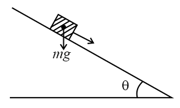EASY
Earn 100
The ratio of the limiting force at friction- to the normal reaction- is known as
(a)Coefficient of friction
(b)Force of friction
(c)Angle of friction
(d)None of the above
50% studentsanswered this correctly
Important Questions on Friction
HARD
EASY
MEDIUM

MEDIUM
EASY

Given in the figure are two blocks and of weight and , respectively. These are being pressed against a wall by a force and kept in equilibrium as shown. If the coefficient of friction between the blocks is and between block and the wall is , the frictional force applied by the wall on block is:

